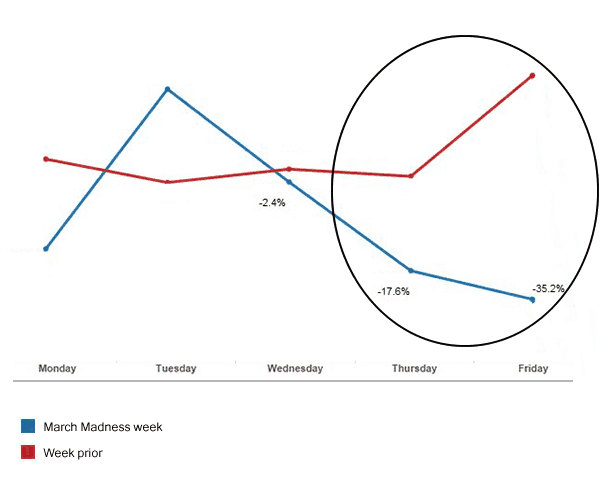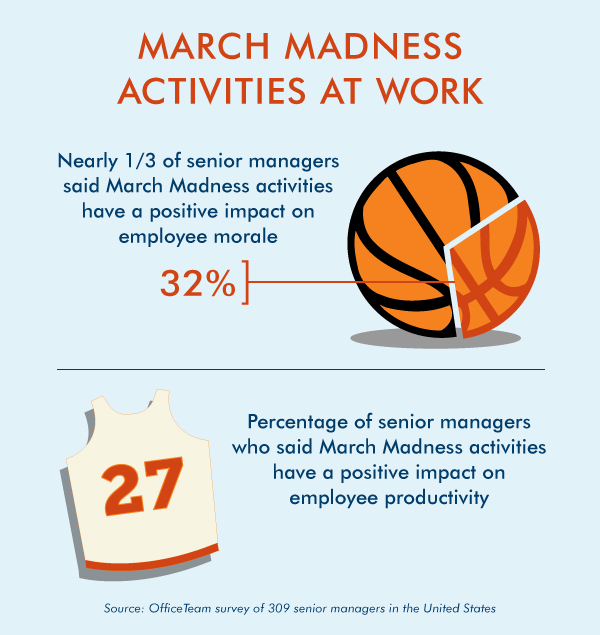Does March Madness Affect Collaboration?
Blog post for Smartsheet, a cloud-based work management tool.
Money and March Madness go hand in hand. From money gained (up to $1 billion from Warren Buffett for the perfect bracket) to money lost ($1.2 billion for every unproductive work hour during the first week of the tournament), it’s all about the green.
But, it’s no longer fun and games when companies become concerned about millions of dollars potentially lost in productivity and collaboration during the tournament.
There’s a lot of competing statistics on how March Madness affects productivity at work. In its annual survey, Challenger, Gray & Christmas, Inc. found that 50 million Americans will participate in office pools and companies stand to lose a collective $1.2 billion for every unproductive work hour during the first week of the tournament.
On the other hand, a 2014 OfficeTeam survey of 309 senior managers in the United States found that nearly 33% of senior managers said March Madness activities have a positive impact on employee morale. And 27% said they have a positive impact on employee productivity.
What really happens at work during the March Madness tournament? Are the games good for morale or do they result in valuable time lost?
Looking at Work Trends During March Madness
We wanted to find out for ourselves.
At Smartsheet, we look at a lot of anonymous app data to gain insights about the way we work, and to learn how to make the product even better. All data remains private and secure.
We analyzed work activity on March 20th (Thursday) and March 21st (Friday) 2014, the two days that games aired during the work day.
We compared activity during the week of March Madness to the week prior, when there was no reason to be distracted from work. The red line is the week before March Madness and the blue line is the week of March Madness.
Significant Decrease in Sheet Sharing Means Less Collaboration

“Sheet sharing” is when a user shares their Smartsheet “Sheet” with a colleague or external collaborator. Each sheet contains notes, discussions, files, and information about a project, and users can share their project plans with team members to collaborate in real-time, stay on top of deadlines, and provide status updates.
This action is one of the biggest indicators of collaboration, as it is directly tied to working with other people. If you don’t share a sheet, you’re most likely working independently on a project.
Based on the number of sheet-sharing actions in Smartsheet last March, we saw a huge dip in sharing activity on the two days of March Madness games. There was an 18% decrease in sheet sharing on Thursday and a 35% decrease on Friday, compared to the week before.
This is a significant drop in activity, and one that we don’t see very often. But it makes sense when March Madness games are airing during the workday. Employees are more distracted, perhaps watching the game on one screen and working during time-outs or commercials. Distraction does not lend itself to collaboration, and, as we already know, multitasking reduces our productivity and collaboration.
Yes, Collaboration Decreases, but Should You Outlaw March Madness?
So, what does this mean for you? Should you impose some basketball boundaries to keep collaboration intact?
A good rule of thumb is, “moderation in all things.” There’s nothing wrong with employees wearing their jerseys to work or chatting about their brackets with colleagues. The line gets fuzzy when employees start watching the games with undivided attention, letting deadlines slip and questions unanswered. There’s no “best way” to handle that — we’ll leave that one up to you as it greatly depends on your company culture.
However, if one of your employees happens to win Warren Buffett’s $1 billion prize for a perfect bracket, we’ll be more than happy to help you with that.
How does your office handle March Madness? Do you think it’s a time-waster or a fun way to boost morale? Let us know in the comments!

